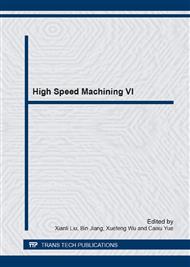[1]
S. Smith, J. Tlusty. An overview of modeling and simulation of the milling process, Transactions ASME Journal of Engineering for Industry 113(1991)169–175.
DOI: 10.1115/1.2899674
Google Scholar
[2]
A. E. Bayoumi, G. Yucesan, L. A. Kendall. An analytic mechanistic cutting force model for milling operations: A theory and methodology, Transactions ASME Journal of Engineering for Industry 116(1994) 324–330.
DOI: 10.1115/1.2901948
Google Scholar
[3]
A. E. Bayoumi, G. Yucesan, L. A. Kendall. An analytic mechanistic cutting force model for milling operations: A case study of helical milling operation, Transactions ASME Journal of Engineering for Industry 116(1994) 331–339.
DOI: 10.1115/1.2901949
Google Scholar
[4]
W. A. Kline, R. E. DeVor. The effect of runout on cutting geometry and forces in end milling, International Journal of Machine Tool Design and Research 23(2/3)(1983) 123–140.
DOI: 10.1016/0020-7357(83)90012-4
Google Scholar
[5]
J. W. Sutherland, R. E. DeVor. An improved method for cutting force and surface error prediction in flexible end milling systems, Transactions ASME Journal of Engineering for Industry 108(1986) 269–279.
DOI: 10.1115/1.3187077
Google Scholar
[6]
Y. Altintas, A. D. Spence. End milling force algorithms for CAD systems, Annals CIRP 40(1)( 1991) 31–34.
DOI: 10.1016/s0007-8506(07)61927-1
Google Scholar
[7]
Shui-Jin Li, Yun-Fei Zhou, Ren-Cheng Jin, et al. Dynamic force modelling for a ball-end milling cutter based on the Merchant oblique cutting theory, International Journal of Advanced Manufacturing Technology 17(2001) 477-483.
DOI: 10.1007/s001700170147
Google Scholar
[8]
T. S. Lee, Y. J. Lin. A 3D predictive cutting-force model for end milling of parts having sculptured surfaces, International Journal of Advanced Manufacturing Technology 16(2000) 773-783.
DOI: 10.1007/s001700070011
Google Scholar
[9]
P.Q. Guo, S.R. Wang, J.P. Shi, et al. Research on dynamic performance of milling system for parallel indexing cam contour milling, Key Engineering Materials 392-394(2008) 156-160.
DOI: 10.4028/www.scientific.net/kem.392-394.156
Google Scholar
[10]
Minghai Wang, Lei Gao, Yaohui Zheng. An examination of the fundamental mechanics of cutting force coefficients, International Journal of Machine Tools & Manufacture 78(2014) 1-7.
DOI: 10.1016/j.ijmachtools.2013.10.008
Google Scholar


